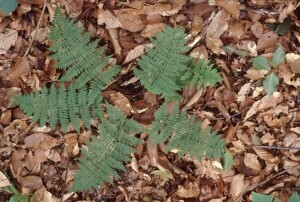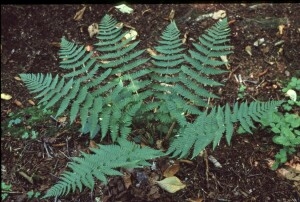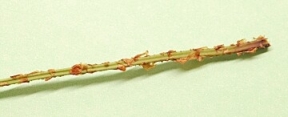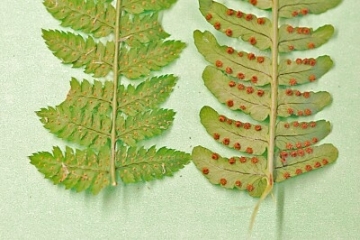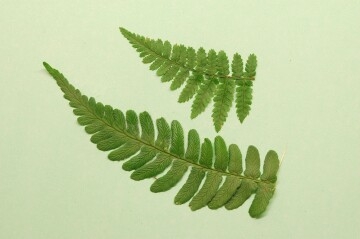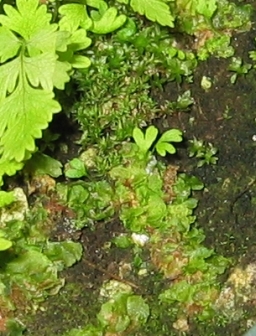Some Green in the Snow - evergreen Dryopteris spp.
Name derivation:
Dryopteris is from the Greek name drys, meaning oak, and pteris, used for many ferns, from pteron, meaning wing (ref 7,9). Dryopteris intermedia: intermediate, probably between carthusiana & campyloptera (ref 9). Dryopteris marginalis: margined, referring to position of sori (ref 9). These ferns were previously placed in the genera Aspidium and Thelypteris. Commonly called "Buckler ferns", wood ferns, and shield ferns. (For Latin synonyms, see further reading at the end.)Description:
Dryopteris spp. have brown-to-golden scales on the rachis and stipe, especially at the base. Both evergreen wood ferns have fronds up to 30" long; D. intermedia can be 8" wide, D. marginalis up to 10 inches. Fronds are clustered (crowns), and the sori are round with kidney shaped indusia. Dryopteris intermedia is lacy, with sori on the midrib of pinnules, while D. marginalis is leathery, less divided, with sori nearly on the margin of each pinnule. In December, the golden scales, evergreen leaves, lack of "stockings", and placement of sori will be enough to identify these two ferns. In other months, you will need additional characteristics to distinguish D. intermedia from the similar D. carthusiana and D. campyloptera. (See further reading at end)Range & Habitat:
Dryopteris intermedia: Wisconsin to Newfoundland, south to Alabama & Georgia at high altitudes (ref 3,5). Found in nearly every county in New York (ref 1). Very common & widely distributed except on heavier soils, found in damp woodlands and ravine banks, in rich acid or subcalcareous humus (ref 6).
Dryopteris marginalis: Wisconsin to Newfoundland, south to higher altitudes in Oklahoma & Georgia (ref 3,5,10). Found in all counties in New York, as is D. carthusiana (ref 1). A common fern, found on wooded slopes, especially ravines, in light humus over both acid & calcareous soils (ref 6) and on roadsides & rock walls (ref 9).
Both evergreen wood ferns are upland species in New York, although D. intermedia is also found in wetlands in north-central U.S. (ref 3).
Cultivation/propagation/status:
All Dryopteris spp. are NYS DEC Protected as exploitably vulnerable (ref 2), so cannot be collected without permission. Both D. marginalis and D. intermedia are listed as G5, S5, i.e. demonstrably secure, both globally and in NY State (ref 1,11). Dryopteris spp. are readily spore-propagated for use in gardens. Spore propagation techniques are described in many references; I like the detailed description in Foster (ref 5).
I simplify by using plastic containers in loosely closed plastic bags, but the basics are the same. Dryopteris intermedia is hardy to USDA zone 3 (ref 9) and is happiest in the garden in deep rocky neutral to slightly acid soil that is rich in humus. It needs shade and is particularly happy (and pleasing) at the base of boulders (ref 4). Sources differ on water needs, some saying it needs moisture at all times, but Leopold says that in this area it can take some dryness once established (ref 8). Dryopteris marginalis is hardy to USDA zone 2 (ref 9), preferring deep stony, well-rotted leaf compost, in full to open shade (ref 4). Again, boulder bases are good spots, and the water recommendations range from keeping moist to "very drought tolerant once established" (ref 8).
Interesting bits:
The fertile leaves of D. intermedia appear first in the spring; sterile leaves are similar in shape but smaller. Dryopteris intermedia & D. carthusiana are commonly used by florists (picked mid-summer & held in cold storage). Dead matted leaves surrounding the crown of D. marginalis can help stabilize soil on slopes. Some Dryopteris spp. have poisonous roots, and although medicinal uses are listed, they are thoroughly circumscribed with precautionary statements due to possible toxicity.
Dryopteris spp. hybridize in the wild. The diagram for known hybrids in Flora of North America (ref 10) looks like spaghetti. No wonder there are so many not-quite-on-spec examples out there.
Further Reading...
Synonyms, Characteristics for Year-round Identification & References
About
By Rosemarie Parker
Photos by Paul Schmitt and David Werier


